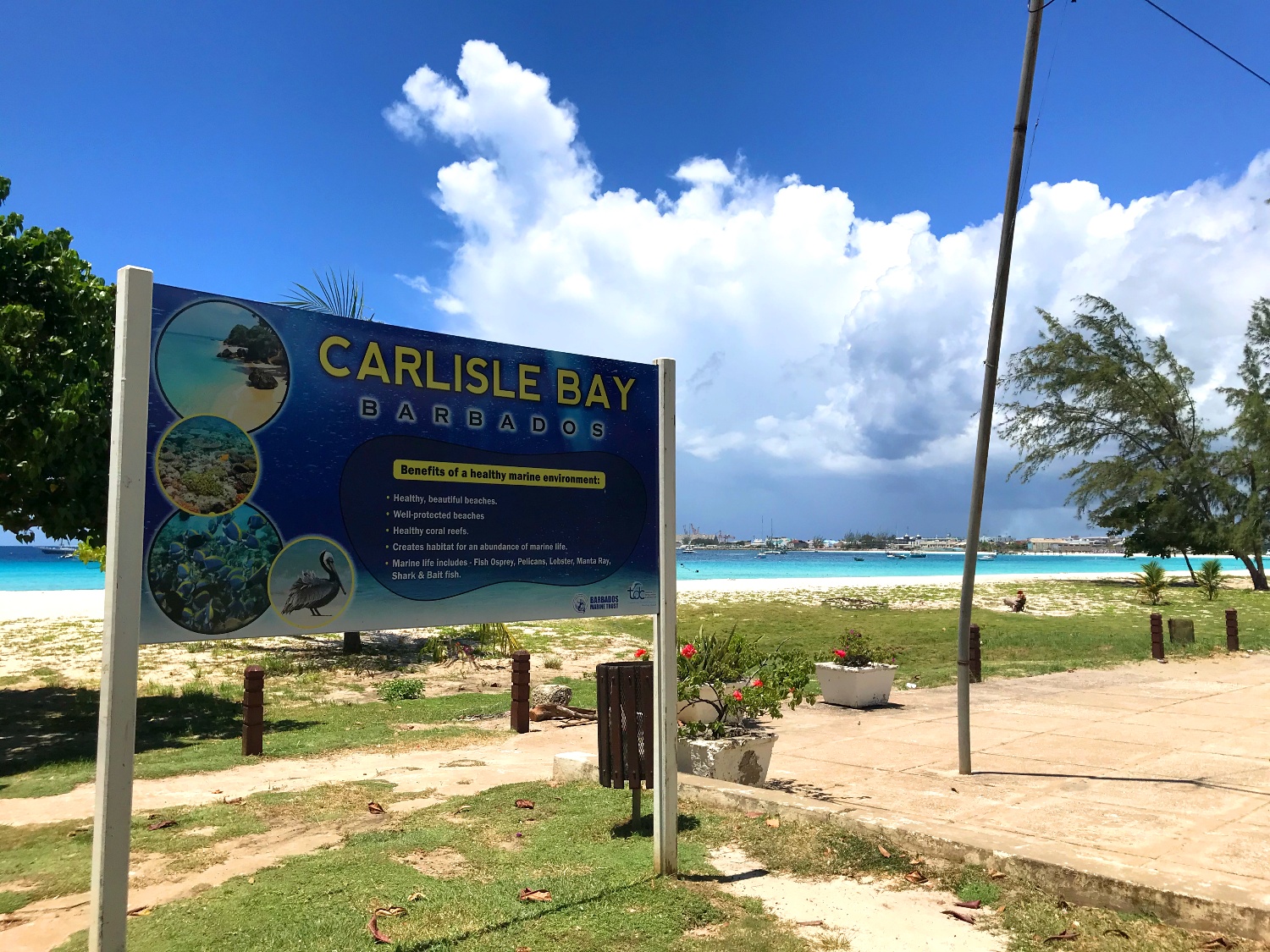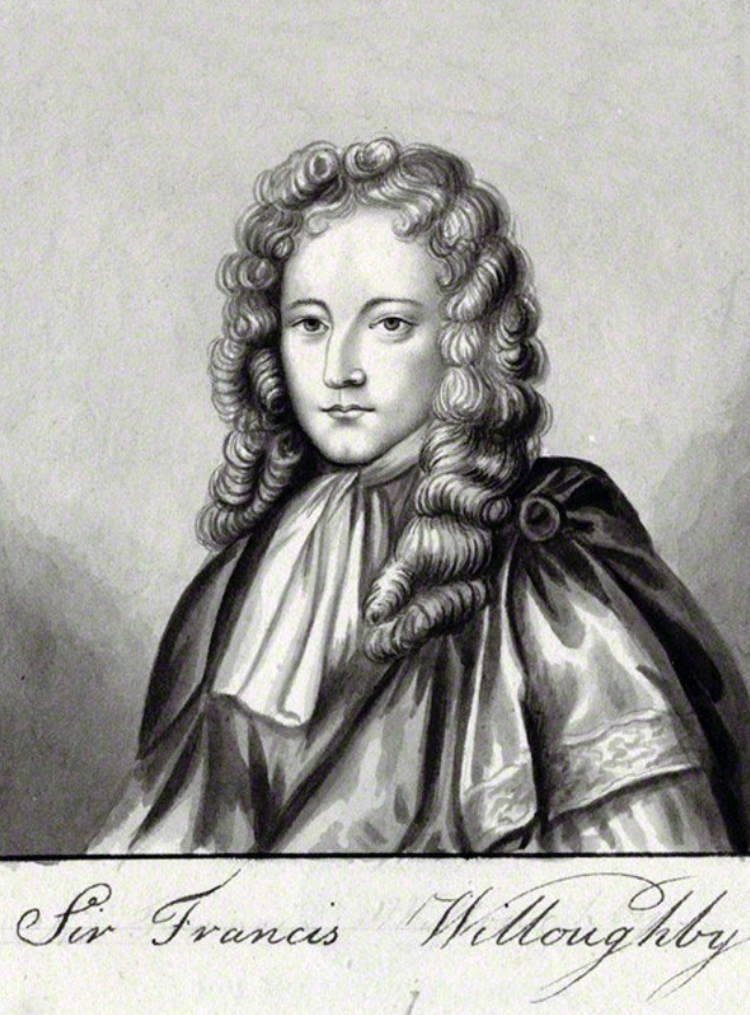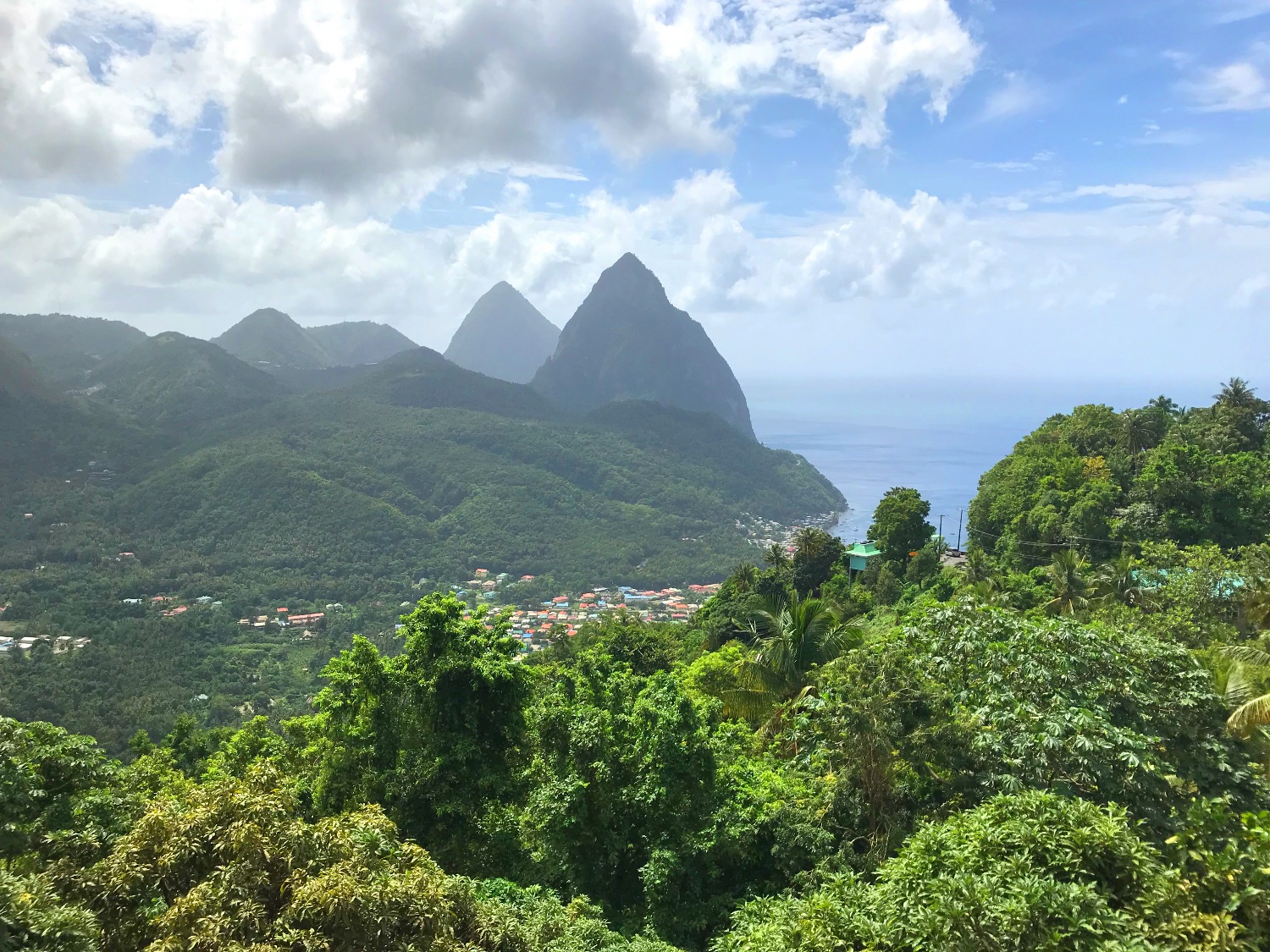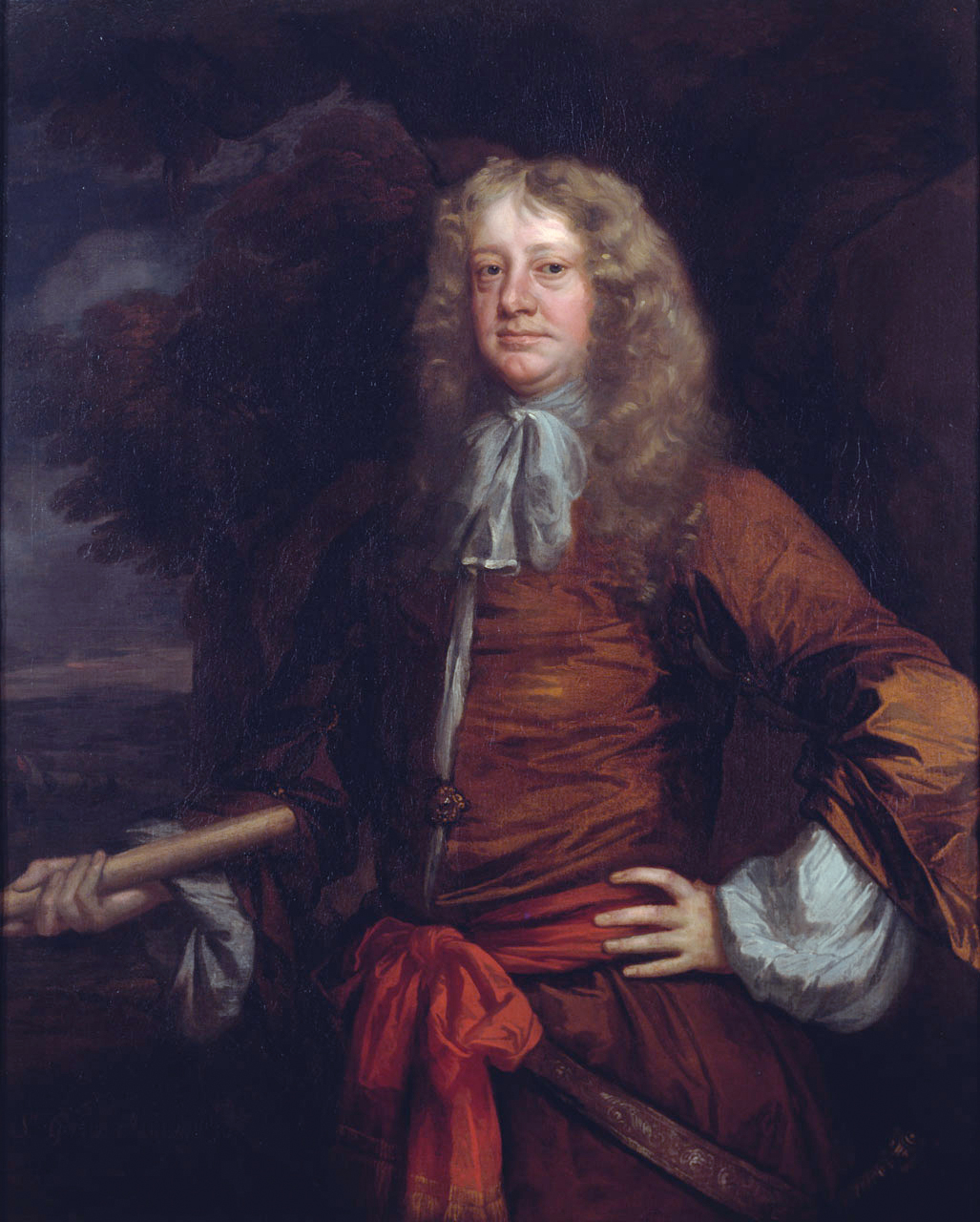Barbados: A Walk through History (Part 4)
Section 3 The Island Tossed About by the English Civil War

(View from the beach at Carlisle Bay)
(Section 3 was originally published in December 2021 under the title “The English Civil War and Barbados” in the Kasumigaseki Foreign Service Association’s monthly bulletin. Parts have been added and revised for this column.)
England started its colonization of the Caribbean Islands in the first half of the 17th century. Separately, a new movement was beginning in North America.
In 1620, the English ship Mayflower arrived at the east coast of what is presently the State of Massachusetts. Onboard were a group of Puritans, English Protestant Calvinists. Those onboard the ship were fleeing from the persecution they were facing in England due to the expanding power of the Church of England under the rule of James I. These “Pilgrim Fathers” as they were called, settled with not a penny to their names as they built the colony Plymouth from the ground up.
Incidentally, at this time the English merchant navy also landed on the eastern brink of Asia, Japan. However, England lost the trade competition to the Dutch for the Japanese market, and thus closed the doors of its trading house at Hirado port and left Japan. This took place when Tokugawa Iemitsu became the 3rd Tokugawa shogunate, in other words in the year 1623, which puts the arrival of the Mayflower in North America a few years prior.
On the other hand, as previously mentioned, Barbados became an English colony in 1627, but soon the crafty Earl of Carlisle will beguile the rights to the colony. Over on the island the “tyrant Governor Hawley” will cause the settlers to suffer by placing a heavy tax on them under the instigation of Carlisle. As Hawley’s ten years of misrule was about end, turbulent times were about to begin in its colonial master, England.
*********************************************
Outbreak of Revolution
Around this time Charles I, who was deceived by the Earl of Carlisle to grant him the proprietorship to Barbados, succeeded his father James I to become the next King of England. King Charles I, just like his father, advocated the “Divine Right of Kings” theory, setting up an autocratic rule which ignored the role of the parliament. However, around the same time Puritan influence was gaining domestically and in parliament due to discontent towards the Anglican Church, deepening the rift between Royalists (“Cavaliers”) and Parliamentarians (“Roundheads”).
While Charles I arbitrarily abstained from holding parliament sessions for 11 years, a rebellion in Scotland occurred when he tried to coerce Scotland where Presbyterianism was dominant into the Anglican Church. Charles I was obliged to convene Parliament in order to procure funds to suppress the rebellion; however, Parliament refused to agree with the King’s initiative for new taxation, forcing England into civil war when armed conflict broke out between Charles I and his followers (Royalists) and Oliver Cromwell and the Parliamentarians. This is the start of the “Puritan Revolution” – the English Civil War.
Baron Willoughby, Caught in the Whirlpool of Revolution
There was a man named Francis Willoughby (1613-1666), born in Suffolk to a family of Baron status. He inherited his father’s place in the House of Lords upon becoming an adult.
Willoughby originally sided with Cromwell in the beginning of the revolution, joining the Parliamentarians. However, soon he became disenchanted with the radical Cromwell, who was plotting on overthrowing the royal government, and became one of the leaders of the more moderate Presbyterian side within Parliament. This will link Willoughby to Barbados later on.
Upon occupation of London, Cromwell captured Charles I and threw Willoughby in jail in order to expel from Parliament any Presbyterians who wished to maintain the constitutional monarchy. Charles I eventually met a violent death when he was beheaded in 1649 by Cromwell’s Parliamentarians. England, now without a King and its monarchy disrupted, began its journey to becoming a republic.
On the other hand, although Willoughby’s assets were seized, he was released from jail a few months later. He pledged allegiance to Charles II, son of Charles I, and after joining him and other exiled Royalists in the Netherlands, made his way across the Atlantic towards the colony of Barbados in hopes of making a new start. This was the year 1650.
There was a person behind Willoughby’s voyage to Barbados, someone who was in the favor of Charles II and his followers, with possessing the rights to the island’s proprietorship. He was the 2nd Earl of Carlisle, the son of the 1st Earl of Carlisle, and upon his father’s death he succeeded the rights to the island. Barbados was what linked two generations of kings and earls. The following is how Willoughby came to be by their side.
After the outbreak of the Civil War, both Royalists and Parliamentarians wanting to escape the chaos in England fled to Barbados as settlers. There were a number of Royalist aristocrats who made their way to Barbados. As a way to regain their lost assets on the mainland the settlers put their efforts into running sugar plantations, which was on its way to becoming the island’s main lucrative industry. The transatlantic slave trade between West Africa and the Caribbean region was growing too as a reliable workforce was necessary to support the plantations. Plantation owners who were successful reaped in vast wealth, building luxurious houses equal to those standing in England. This is when the moniker “Little England” started to come into use to describe Barbados.
This is how Royalists and Parliamentarians became intermixed in Barbados society, supposedly getting along fairly well considering their respective stances back in England. There was an arrangement between the two sides called “The Treaty of Turkey and Roast Pork”, which had a clause half-jokingly stating that as punishment for whoever said the words “Cavaliers” or “Roundheads” had to treat whoever heard the “forbidden word” to a meal of turkey and roast pork. It is said that there were times where someone said the “forbidden word” on purpose to converge both sides to start a boisterous revelry.
However, the situation changed dramatically when Charles I was beheaded and Cromwell’s military dictatorship took over. Persecuted Royalists fled in large numbers from England to Barbados, disrupting the balance between the Royalists and Parliamentarians. Royalists in Barbados, who claimed Charles I was a martyr, seized the assets of Parliamentarians, overtly suppressing the Parliamentarians. The leader of the Barbadian Royalists was a man named Colonel Humphrey Walrond, who swore his loyalty to the exiled king Charles II in the Netherlands, claiming the king as the ruler of Barbados.
At the time the Governor of Barbados was a man named Philip Bell, who was under the patronage of the 2nd Earl of Carlisle. He introduced administrative reforms such as dividing the island into 11 different parishes under the Anglican Church (note 1), proving himself a steady man of practicality. However, the 2nd Earl of Carlisle thought that the conflict between the Royalists and Parliamentarians was too much for Bell to handle, and after observing his lack of abilities sent in Francis Willoughby to replace him. Looking at the situation from the point of view of the 2nd Earl of Carlisle, who had been living in the proceeds of the wealth that Barbados produced, returning the island to peace and restoring its profit was more important than the ideological rift between Royalists and Parliamentarians.
The new Governor Willoughby worked at trying to placate Colonel Walrond while putting out the flames between the Royalists and Parliamentarians, as well as cancelling the forfeiture of the Parliamentarians’ assets.
These were not his only achievements; he also approached Surinam, located northeast of the South American continent. At the time, both English and Dutch settlers were living there; Willoughby’s armed fleet built a fort in the center of the English settlement. The fort was named “Fort Willoughby”, later to become what is currently the capital of Surinam, Paramaribo (note 2).

(Portrait of Francis Willoughby)
However, as one hurdle was cleared another one appeared. This time, a more serious situation had arisen-English naval ships had come to attack Barbados.
What led to this attack on their own colony?
It is natural that Cromwell’s England had a loathing towards the little island of Barbados, where the Royalists were still in majority. However, there was an additional reason as to why England became infuriated by its own colony.
The reason had to do with the relationship between Barbados and the Netherlands. When Barbados became an English colony, the island exported its tobacco, cotton, and other crops to England, and in return England would ship back new settlers and daily commodities. However, as the Civil War shook up England’s internal situation, the trade between the two came to a stand still, allowing the Dutch to wedge themselves in.
The trade relationship between Barbados and the Netherlands quickly expanded in part because Dutch goods were cheaper than what the English provided. Also, the Dutch were the first to introduce African slave labor for sugar cane cultivation and plantation work to the Barbadian settlers.
The Netherlands was ruled by the Spanish Hapsburgs for a long period of time, but in the latter half of the 16th century when the Netherlands was in the course of independence, the newly sovereign country’s economy rapidly developed. They advanced their way around the world through intermediary trade, making Amsterdam the international financial center. It made the Dutch East India Company its foothold while moving into Asia; the Tokugawa Shogunate had just begun closing off Japan to the outside, allowing only the Netherlands among European stats to establish a trading house on the island of Dejima, Nagasaki. This was in the year 1641, exactly around the time that the Civil War was happening back in England.
England came to loathe the strengthening connection between the ascending Netherlands and the colony of Barbados.
As seen before, the English approach to colonial management in the Caribbean was not by taking land by force using its regular navy and warships, but to let the aristocrats and merchants use their own assets to send ships at their own risk. Then, with the permission of their mother country, they declared, “the new found land now belongs to England.” They proceeded to abuse the natives and slaves, exploiting the natural wealth by mining mineral resources and running plantations, and the homeland received a cut of these profits.
In other words, this system of “I grant you permission to declare this land a part of England" is similar to the modern franchise system of businesses such as convenience stores. What Barbados was doing with the Netherlands was going behind the convenience store’s parent company - England - and buying and reselling products from their rival -the Netherlands - in order to make a profit; understandably England became angry with Barbados for trading with the Netherlands.
At this time Western Europe was under the influence of mercantilism; in order to finance war expenses and the upkeep of military and their bureaucratic institutions, western European countries were increasing their exports to the maximum and keeping imports to a minimum, focused solely on accumulating their wealth. In order to do this they picked a quarrel with competing countries and placed high import taxes on the products; another method was even to ban all trades with competing nations altogether. This may seem reminiscent of today’s world, and the problem of this method would frequently lead to wars between competing countries.
Similar accounts to Barbados’ were occurring in other colonies as well, thus Cromwell’s England introduced The Navigation Act of 1651, instating a trade embargo between its colonies and the Netherlands (note 3). In modern terms, “decoupling”; this law is what led to the Anglo-Dutch wars later on.
The English Fleet Suppresses Barbados
Under such circumstances, Barbados continued to openly trade with the Netherlands, forcing angry England to send its naval fleet to subjugate its rebellious colony. This was the first time that the English navy officially landed in Barbados. Leading the naval fleet was Admiral George Ayscue.
Governor Willoughby, while Ayscue’s fleet was closing in on Barbados, rebelled against England stating that “Barbados has no reason to abide by laws decided upon in England without representation”. This was Willoughby’s way of expressing “I don’t know what you’re talking about. That nitwit Cromwell’s England is nothing of value to me”. It might be inevitable that he was overreaching his position, but it seems that Willoughby was a man of edgy character.
Willoughby placed militia forces at the key points of the shore of Carlisle Bay, having the main settlement of Bridgetown, as well as Holetown, and Speightstown in wait to ambush Ayscue’s approaching fleet, with the Netherlands providing weapons and goods to Barbados.
The English navy fleet headed by Ayscue captured the Dutch merchant ships stationed in Carlisle Bay; however, Willoughby had stationed a strong camp of 6,000 infantry and 400 cavalry among the coast line. Ayscue considered it not easy to subdue the island, and called for Barbados to surrender from the sea. In response, Willoughby rebuked Ayscue’s calls for surrender saying “We do not answer to any authority except the King of England. We will protect our island.”. Ayscue then took to the strategy of starving the inhabitants of Barbados by blocking the seas around the island from other ships entering.
The small island faced a desperate situation; to worsen the situation, Ayscue made a surprise attack with 400 soldiers landing on the island, inflicting great damage on Barbados. A portion of the inhabitants who were upset by what was happening betrayed the island and joined Ayscue’s fleet in Oistins, then called Austin’s Bay, located east from Carlisle Bay.
This betrayal by Willoughby’s followers forced him to agree to attend peace talks with Ayscue. At the end of the talks, held at the Mermaid Tavern in Oistins, the “Charter of Barbados” was signed between both camps.
Looking at the contents of the Charter, Barbados did not unconditionally surrender; there is evidence that both sides made considerable concessions. While the Charter guaranteed the seized assets off the Parliamentarians-in other words Cromwell’s supporters-to be turned back to their owners, the return of the Royalists’ assets seized in England was permitted to be returned as well. Other clauses included the right to freedom of religion, taxation of residents required the approval of the Barbados Parliament, Parliament members were to be elected from land owners on the island, and the acceptance of Barbados’ right to free trade (note 4), and other clauses, making the Charter rather progressive for its time.
The Charter of Barbados was officially approved by the English Parliament the following year in 1652.

(Portrait of George Ayscue)
If Willoughby had not surrendered and ended up fighting a ground war against Ayscue’s forces, Barbados’ history would have been quite different. However, Willoughby, who made an “honorable surrender” was dismissed from his position as governor and returned to England. It was none other than Ayscue who followed as Governor of Barbados.
It is a mystery as to why Willoughby was not imprisoned and/or executed; looking carefully at the Charter of Barbados, the assurance of Willoughby’s assets and even freedom of his movement is stipulated in the document. It is unclear whether Ayscue was trying to be a “gentleman”, or if there was some sort of deal between him and Willoughby when the Charter was signed.
However, a peaceful life was not in store for Willoughby upon his return to England. In 1653 Cromwell became Lord Protector for life and established a harsh military dictatorship. Willoughby found himself caught up in internal wiles, and was thrown into jail twice.
While people’s discontent over Cromwell’s harsh rule was festering, he died of illness in 1658, letting the Presbyterians regain momentum in the Parliament and calling back Charles II from exile in 1660, restoring the English monarchy and its monarchial government.
To Barbados, Again
Willoughby’s connection to Barbados comes around once again.
In 1663, after Willoughby crossed the Atlantic and returned to Barbados, he was reinstated as the governor of Barbados by Charles II. However, he did not devote himself to leading a quiet rule over the island as one may think; in fact he left the governance of the island up to his substitute while he went on expeditions to the neighboring islands.
First off was Saint Lucia, located to the west of Barbados. At the time it was under French rule, but Willoughby’s fleet seized their fort and stole the island by blatantly using an excuse that “the natives agreed to sell the island to England” (note 5).
After St. Lucia, Willoughby and his fleet made their way to the Dutch-occupied island of Tobago the south. Upon arriving, he discovered that an Englishman named Robert Searle and his armed men-most likely privateers turned pirates-had landed before him and were looting the settlement there. Willoughby convinced him to stop his heinous behavior and installed an English garrison on the island.
Willoughby Meets an Untimely End in the Caribbean Sea
On July 28th 1666 the Governor Barbados, Baron of Willoughby set out on his last voyage.
His fleet this time comprised of 16 vessels and 1,000 soldiers, heading faraway northwest toward the Island of Saint Kitts (also known as Island of Saint Christopher) to take back the island from the French (note 7). Halfway through the voyage, Willoughby attacked the French-ruled Island of Guadeloupe and captured two of their merchant ships. His plan was to stop at the islands of Nevis and Antigua to pick up supplies before heading toward St. Kitts to launch his attack.
However, shortly before reaching St. Kitts, Willoughby’s fleet was met with tragedy on the night of August 4th. Hurricane season in the Caribbean spans from May to November every year. A hurricane slammed straight into Willoughby’s fleet, which had set sail right in the heart of the season. Many of the ships were damaged, and the flagship “Hope” which Willoughby was on board sank. Willoughby, his ship, and his destiny together disappeared into the depths of the Caribbean Sea.
Francis Willoughby was born in the aristocracy, flung himself into the whirlpool of a revolution, and ran back and forth across the Atlantic Ocean and Caribbean Sea with Barbados as his stage. Rich in upheaval, his life represented the hidden energy of the rise of the English, who were to rule the world’s oceans in the years to follow.
Although Willoughby was no longer among the living, Barbados continued making a fortune through sugar exports, and until being taken over by Jamaica at the end of the 17th century (note 8), it was the most prosperous island among colonized Caribbean islands under English rule, also known for its dark side-a center of the Caribbean slave trade.
*********************************************
Carlisle Bay, where Willoughby and Ayscue confronted each other.
Currently, the Bay is home to Hilton and Radisson resort hotels and fashionable restaurants. The Prime Minister’s offices are across the sea-front street, on the inland side. One can observe people enjoying sailing and scuba diving on the white sand shores where tourists from Europe and America come to relax.
One day in 2019, when I was walking along a small street slightly apart from the main tourist area of Carlisle Bay, I happened upon the remains of a stone building, surely a handsome building in its day, crumbling away and covered in weeds. The deserted building was surrounded by a thick stone fence, and there were what seemed to be holes in a line drilled through the stone. After closer inspection, I realized that they were embrasures (openings for rifles) opening towards the seaside!
I imagined it might be Willoughby and his followers who created these embrasures that look out onto the clear blue waters of the Caribbean Sea in order to protect their island, Barbados by shooting at the approaching English fleet.
(Continues to Part 4 “The Genealogy of Pirates”)

(Island of St. Lucia, which Willoughby snatched from France. The Pitons, or the “Twin Peaks”, which can be seen from a distance, were designated a UNESCO World Heritage Site in 2004)
(Note 2) England and the Netherlands fought over the territorial rights to Suriname, but in 1667 the Treaty of Breda was signed, giving Dutch-occupied New Amsterdam in North America (current day New York) to England, and in exchange Suriname was transferred to the Netherlands, renamed Dutch Guiana. Suriname gained independence from the Netherlands in 1975.
(Note 3) In the book “History of Barbados” published in 1848, the historian Robert Schomburg wrote the following: “If the Navigation laws led to England’s supremacy on the seas, that small island (Barbados) was the cause which led to the navigation laws.”
(Note 4) There was a provisory condition attached to the “freedom of trade” clause in the “Charter of Barbados”, limiting free trade to “nations that do trade and are in amity with England”. In other words, the Netherlands, who was the target of the Navigation Act, was excluded from the “freedom of trade” provision.
(Note 5) Battles were continually unfolding between England and the Netherlands over the ownership of St. Lucia, exchanging hands 14 times before eventually being declared an English territory in the Treaty of Paris of 1814 after the Napoleonic Wars ended. St. Lucia gained independence in 1979 from the UK.
(Note 6) The circumstances of the island of Tobago are further complicated than those of St. Lucia. Control of the island changed 31 times between several countries, and just as St. Lucia, was turned over to England together with the neighboring island of Trinidad in 1814, becoming the independent nation of Trinidad and Tobago in 1962. Interestingly, among the powerful England, France, and the Netherlands that fought over Tobago was the Duchy of Courland and Semigallia on the Baltic coast, now currently a part of Latvia. It ruled over Tobago for a number of decades in the latter half of the 17th century, naming the island “New Courland”, and is said to be the smallest colony on the New Continent.
(Note 7) St. Kitts also changed hands between England and France numerous times. The Treaty of Utrecht, which brought the War of the Spanish Succession to an end, confirmed the island as English territory in 1713. In 1782 France again attacked the island, but was returned the following year to England under the Treaty of Versailles (this treaty was signed between England, France, and Spain as a peace treaty ending the American War of Independence). In 1983 it joined the southern neighboring island of Nevis to become independent from England under the name of “St. Kitts and Nevis”.
(Note 8) The then-Spanish colony of Jamaica was taken over by England in 1655 and afterwards underwent rapid development, eventually surpassing Barbados’ sugar production by the end of the 17th century.
(This column reflects the personal opinions of the author and not the opinions of the Ministry of Foreign Affairs of Japan)
WHAT'S NEW
- 2025.5.15 UPDATE
EVENTS
"417th Lecture Meeting Regarding Global Issues"
- 2025.4.17 UPDATE
EVENTS
"416th Lecture Meeting Regarding Global Issues"
- 2025.3.13 UPDATE
EVENTS
"415th Lecture Meeting Regarding Global Issues"
- 2025.2.20 UPDATE
EVENTS
"414th Lecture Meeting Regarding Global Issues"
- 2025.1.16 UPDATE
EVENTS
"413th Lecture Meeting Regarding Global Issues"
- 2025.1.12 UPDATE
PROJECTS
"Barbados A Walk Through History Part 15"
- 2024.12.19 UPDATE
EVENTS
"412th Lecture Meeting Regarding Global Issues"
- 2024.12.4 UPDATE
PROJECTS
"Barbados A Walk Through History Part 14"
- 2024.11.21 UPDATE
EVENTS
"411th Lecture Meeting Regarding Global Issues"
- 2024.10.17 UPDATE
EVENTS
"410th Lecture Meeting Regarding Global Issues"




